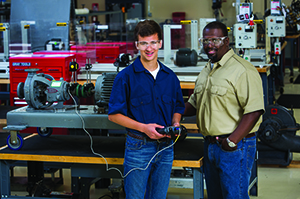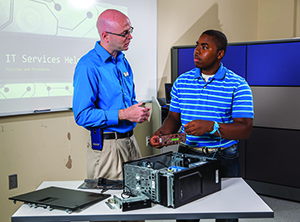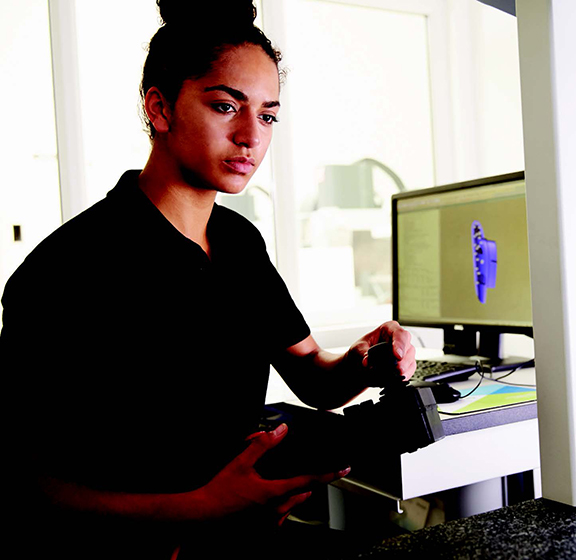PLTW Engineering Assistant:
Duties may include:
Using CAD systems to create 2D and 3D design plans for use in:
- Project scheduling
- Engineering drawings
- Managing program files
- Writing/updating technical documents
- Collecting data
Engineer Pathway applicants must complete (or have completed) four PLTW classes at their high school, including Introduction to Engineering Design and Principles of Engineering.
Engineering Technician Pathway applicants must complete (or have completed) two PLTW classes at their high school - Introduction to Engineering Design and Principles of Engineering.

Manufacturing:
Duties include:
- Reading technician manuals to understand equipment and controls
- Disassembling machinery and equipment when there is a problem
- Repairing or replacing broken or malfunctioning components
- Performing tests and running initial batches to make sure machines are running smoothly
- Adjusting and calibrating equipment and machinery to optimal specifications
Industrial mechanics are employed across the manufacturing spectrum in a variety of venues, buildings, industrial complexes, plants and factories.

Duties include:
- Working from blueprints, sketches or computer-aided design (CAD) files
- Setting up, operating and disassembling manual, automatic and CNC machine tools
- Turning, milling, drilling, shaping and grinding machine parts to specifications
- Measuring, examining and testing completed products for defects
- Smoothing the surfaces of parts or products
- Presenting finished work pieces to customers and making modifications
Machinists are “the sculptors of the modern age,” producing precision metal parts such as bolts, anti-lock brakes and even bone screws for orthopedic implants. They can work in the aerospace, automotive and medical industries.
Hospitality and Tourism:
Duties include:
- Operate and manage the pastry section of a kitchen, working together with other chefs
- Prepare a variety of baked goods following traditional recipes and innovating new recipes
- Decorate and present pastries and baked goods with taste and creativity
- Monitor and order ingredients, supplies and equipment within budget
- Adhere to health and safety standards
Baking and Pastry professionals are employed in a variety of settings including restaurants, hotels, resorts, corporate centers, banquet halls, country clubs, schools, and hospitals in countries all over the world.
Duties include:
- Checking freshness of ingredients, developing recipes and determining how to present food
- Planning menus and ensuring uniform quality of meals
- Maintaining inventory of food and supplies
- Inspecting supplies, equipment and work areas for cleanliness and functionality
- Monitoring sanitation practices along with following professional kitchen safety standards
Culinary professionals are employed in a variety of settings including restaurants, hotels, resorts, corporate centers, banquet halls, country clubs, schools, hospitals—even the White House.

Duties include:
- Greeting guests and answering questions
- Checking guests in and out, assigning rooms and processing payments
- Tracking occupancy records; taking, confirming or changing room reservations; and providing information on the hotel’s services and policies
- Answering phone calls, taking and delivering messages for guests, and handling guest requests or complaints
Hospitality and tourism professionals may work for hotels, motels, resorts, conference centers, governments, historic venues, cruise lines, and tourist attractions around the world.

Information Technology
Duties include:
- Testing and evaluating network systems
- Performing regular maintenance to ensure networks operate correctly
- Troubleshooting local area networks (LANs), wide area networks (WANs) and Internet systems

Duties include:
- Writing programs in a variety of computer languages such as C++ and Java
- Updating and expanding existing programs
- Debugging programs by testing for and fixing errors
- Building and using computer-assisted software engineering (CASE) tools to automate the writing of code
- Using code libraries—collections of independent lines of code—to simplify the writing
Computer programming professionals write the code that turns program designs created by software developers and engineers into instructions that a computer can follow. They work in varied settings from corporations, non-profits and government agencies to colleges and universities.

Duties include:
- Data analysis
- Forensics investigation
- Network monitoring and defense
- Risk identification and mitigation
Individuals in this field can work in varied settings, including large corporations, manufacturing, software development companies, nonprofit agencies, colleges and universities, and government agencies.
Technical Service Industries
Duties include:
- Overseeing installations
- Troubleshooting and repairing HVAC/R equipment
- Applying local HVAC codes in a practical manner on each job
- Provide technical support in the field
- Collaborate with sales and engineering to develop product definitions responsive to customer needs and market opportunities
- Layout, design and install low voltage wiring
- Provide excellent customer service
HVAC professionals work in a variety of settings and some technicians may advance to managerial positions while others may move into sales and marketing jobs. There are HVAC technicians who become building superintendents, cost estimators and system test and balance specialists.

Duties include:
- Inspecting, maintaining and repairing cars and trucks to original equipment manufacturer (OEM) quality standards
- Identifying problems with, and repairing, electronic-controlled engine, transmission and body systems
- Performing basic vehicle care and maintenance
Applicants for an Automotive youth apprenticeship must have a valid S.C. driver's license.

Duties include:
Welding is the joining of materials with or without the application of heat, filler material and/or pressure. In addition to welding, welders:
- Maintain equipment and machinery
- Inspect structures or materials to be welded
- Calculate dimensions
- Review blueprints, sketches and specifications
Skills needed to become a welder include manual dexterity, good eyesight and eye-hand coordination, and the ability to concentrate on detailed work for long periods of time. You should also be able to stoop, bend, climb and work in awkward positions.
Manufacturing, construction and service industries employ the most welders. Welders are needed to work on transportation equipment, industrial machinery and fabricated metal products, as well as bridges, highways and buildings. As current welders retire, the need for skilled welders increases. The Bureau of Labor Statistics says job prospects are good for welders trained in the latest technologies.
Health:
Duties include:
- Fulfilling basic quality-of-life needs for patients
- Serving as the "eyes and ears" of an RN or LPN
- Gathering vital information about a patient's condition
- Relaying information between patients and nurses
CNAs work in a wide variety of settings such as hospitals, nursing homes, adult day care centers, and assisted living facilities.

Duties include:
- Greeting patients
- Answering phones
- Filing and updating medical records
- Completing insurance claim forms
- Arranging hospital admissions and surgeries
- Handling correspondence
- Billing and bookkeeping
- Entering medical histories into electronic health records
Medical office assistants work in the administrative area of a medical office

Engineering Design Graphics:
Duties include using CAD systems to create 2D and 3D design plans for use in:
- Construction
- Manufacturing
- Engineering
- Industrial maintenance manuals
- Mechanical assembly instructions
Design graphics technicians may choose from a broad range of career areas: architecture, manufacturing, engineering, construction, government and other users of graphic communication.

Business Technology:
Duties include:
- Verify, allocate and post financial transactions.
- Manage accounts payable and receivable.
- Reconcile bank statements.
- Prepare payroll entries.
- Assist with budget preparations.
- Prepare minimal individual tax returns.
- Prepare financial statements and reports.
- Analyze financial statements for trends.

Fast Facts About a Career in Transportation Logistics:
- Port-supported jobs pay an average of 32% higher than state's average annual wages
- Average annual wage comparison:
-
- All jobs in SC - $45,189
- All jobs supported by SC Logistics - $48,412
- Jobs embedded within companies (BMW, Bosch, etc.) average salary - $76,592
- More than 140,000 jobs in South Carolina
- US News & World Report has logistics number 26 on their list of 100 best jobs for average salary, job prospects and stress level!

Criminal Justice:
Duties may include:
- Dispatch
- Background checks
- Animal control
- Community service activities
- Records management
- Evidence collection
Completion of the Law Enforcement certificate program equips participants for employment as private security officers and prepares them to continue their education and training at the police academy. In South Carolina, law enforcement officers must be at least 21 years of age.
Applicants for a Security/Pre-Law Enforcement youth apprenticeship must have a valid SC driver's license and be 18 years of age by August of the year they are hired.

Youth Apprenticeship Success Stories
Important Links
ACCUPLACER Test Score Requirements
Youth Apprenticeship Application - New Fillable PDFs
PLTW Youth Apprenticeship Application - New Fillable PDFs
FAQs
Click here for a list of frequently asked questions about youth apprenticeships.
